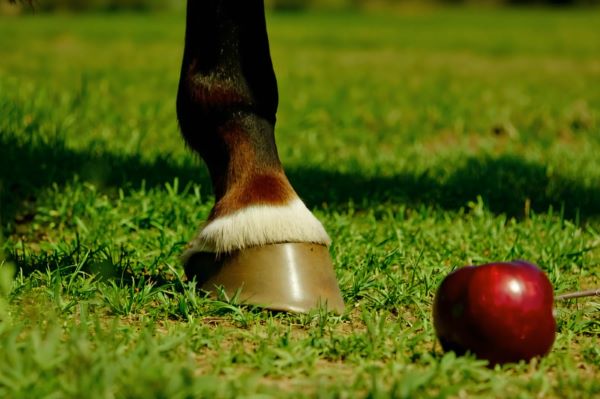What lurks under those shoes? We are what we eat – and so is your horse.
When you pull off those shoes you may well make some unpleasant discoveries.
They are the results of your horse’s diet.
The harsh reality is this. No matter how well you trim, and no matter how much exercise you give, your horse’s hooves cannot improve on a poor diet.
Even more worrying, you cannot keep them safe from Laminitis and Founder.
You know the saying “we are what we eat”. Poor diet often comes from the pastures your horse grazes on.
Today’s domestic horses are often seen on lush, green pastures that are high in sugars. This is almost certainly not a good thing as it allows the horse to eat with minimal movement.
The horse can be overloading on carbohydrates and not burning them off with vigorous exercise. You could compare them with overweight humans.
Compare that to wild horses. Their grazing is generally poor quality, forcing them to keep moving. They’ll spend 18-20 hours a day on the move.
Former farrier Jaime Jackson has been transforming his wild horse research into domestic solutions. If you want to understand natural horse care you really should read his book Paddock Paradise.
He suggests a track system as an alternative to our standard grazing methods. The track should offer variations in terrain, food and shelter. They should be evenly spaced. The longer and narrower (within reason) you make the track, the more you’ll encourage your horses to move.
It works. Not only are Paddock Paradise users enjoying healthier horses, but more land as well. The middle of your pasture is free to use. You may choose to grow hay that’s fitted to your horse’s nutritional needs, thus saving money too.
Jaime Jackson concedes there’s still a great deal of research that needs to be carried out on the lifestyle of Wild Horses. For now, we can be grateful his research has taken us this far.
Click here if you want some more great tips
And now onto Steve.

Hooves and Diet: The Perfect Pair for Healthy Feet
“Let’s chat about hooves and diet—because if you want your horse strutting their stuff with strong, healthy feet, you need to start with what’s on their plate. Hooves and diet go hand in hand, and getting this combo right can save you a ton of headaches (and farrier bills!).”
“First things first: your horse’s hooves are like a mirror of their overall health. If their hooves are cracking, brittle, or sore, the culprit might just be their diet. Good-quality forage is the foundation of every horse’s nutrition. Plenty of hay or access to pasture is key because hooves thrive on a balanced diet rich in fiber, vitamins, and minerals.”
“When it comes to hooves and diet, biotin is the superstar nutrient. This little gem helps promote strong hoof growth and can make a huge difference for horses with weak or slow-growing hooves. You can find biotin in many supplements or even naturally in certain feeds. Omega-3 fatty acids, found in flaxseed or chia seeds, are another great addition—they help maintain moisture and elasticity in the hoof wall.”
“And don’t forget about hydration! A well-hydrated horse has healthier hooves, so make sure they always have access to clean water. A salt block can encourage drinking, too—win-win!”
“But here’s the thing: not all hoof issues are diet-related. Regular farrier care is just as important as a balanced diet. Think of it as teamwork—your farrier takes care of the trim, and you make sure your horse’s diet supports the growth of strong, healthy hooves.”
“So, if you’re serious about hooves and diet, start by evaluating what’s in your horse’s feed bucket. With the right nutrition and care, your horse will be trotting around on hooves that are tough, shiny, and ready for anything! Steve”
Next up
But the wild isn’t divided into tracks… The horses make their own. Maybe we should allow our equines to do the same?
Our farm horses do indeed make their own tracks which we find useful when walking the field to check for weeds and encroaching trees from the hedgerow on our east side of the farm. Because our field is shaped like a comma with the water tank at the south end, the horses get lots of long runs to gallop in and play with each other. The foals and dams and sire are free to interact as a family herd but the mares rule! We will be most interested to see more research on wild horses helping domestic horse keeping. Fred and Joan.